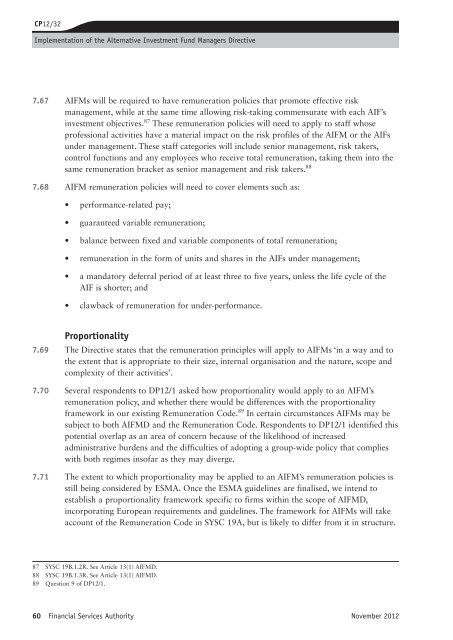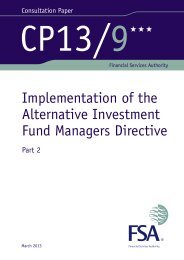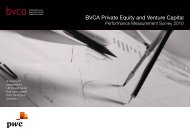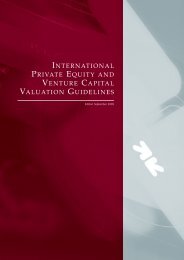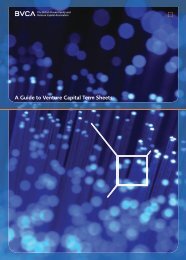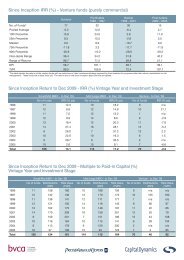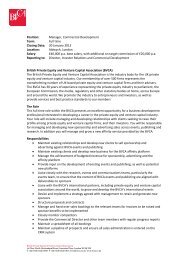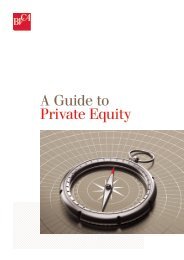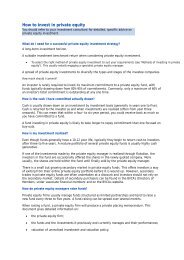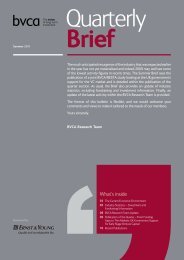CP12/32: Implementation of the Alternative ... - BVCA admin
CP12/32: Implementation of the Alternative ... - BVCA admin
CP12/32: Implementation of the Alternative ... - BVCA admin
You also want an ePaper? Increase the reach of your titles
YUMPU automatically turns print PDFs into web optimized ePapers that Google loves.
<strong>CP12</strong>/<strong>32</strong><br />
<strong>Implementation</strong> <strong>of</strong> <strong>the</strong> <strong>Alternative</strong> Investment Fund Managers Directive<br />
Annex X<br />
7.67 AIFMs will be required to have remuneration policies that promote effective risk<br />
management, while at <strong>the</strong> same time allowing risk-taking commensurate with each AIF’s<br />
investment objectives. 87 These remuneration policies will need to apply to staff whose<br />
pr<strong>of</strong>essional activities have a material impact on <strong>the</strong> risk pr<strong>of</strong>iles <strong>of</strong> <strong>the</strong> AIFM or <strong>the</strong> AIFs<br />
under management. These staff categories will include senior management, risk takers,<br />
control functions and any employees who receive total remuneration, taking <strong>the</strong>m into <strong>the</strong><br />
same remuneration bracket as senior management and risk takers. 88<br />
7.68 AIFM remuneration policies will need to cover elements such as:<br />
• performance-related pay;<br />
• guaranteed variable remuneration;<br />
• balance between fixed and variable components <strong>of</strong> total remuneration;<br />
• remuneration in <strong>the</strong> form <strong>of</strong> units and shares in <strong>the</strong> AIFs under management;<br />
• a mandatory deferral period <strong>of</strong> at least three to five years, unless <strong>the</strong> life cycle <strong>of</strong> <strong>the</strong><br />
AIF is shorter; and<br />
• clawback <strong>of</strong> remuneration for under-performance.<br />
Proportionality<br />
7.69 The Directive states that <strong>the</strong> remuneration principles will apply to AIFMs ‘in a way and to<br />
<strong>the</strong> extent that is appropriate to <strong>the</strong>ir size, internal organisation and <strong>the</strong> nature, scope and<br />
complexity <strong>of</strong> <strong>the</strong>ir activities’.<br />
7.70 Several respondents to DP12/1 asked how proportionality would apply to an AIFM’s<br />
remuneration policy, and whe<strong>the</strong>r <strong>the</strong>re would be differences with <strong>the</strong> proportionality<br />
framework in our existing Remuneration Code. 89 In certain circumstances AIFMs may be<br />
subject to both AIFMD and <strong>the</strong> Remuneration Code. Respondents to DP12/1 identified this<br />
potential overlap as an area <strong>of</strong> concern because <strong>of</strong> <strong>the</strong> likelihood <strong>of</strong> increased<br />
<strong>admin</strong>istrative burdens and <strong>the</strong> difficulties <strong>of</strong> adopting a group-wide policy that complies<br />
with both regimes ins<strong>of</strong>ar as <strong>the</strong>y may diverge.<br />
7.71 The extent to which proportionality may be applied to an AIFM’s remuneration policies is<br />
still being considered by ESMA. Once <strong>the</strong> ESMA guidelines are finalised, we intend to<br />
establish a proportionality framework specific to firms within <strong>the</strong> scope <strong>of</strong> AIFMD,<br />
incorporating European requirements and guidelines. The framework for AIFMs will take<br />
account <strong>of</strong> <strong>the</strong> Remuneration Code in SYSC 19A, but is likely to differ from it in structure.<br />
87 SYSC 19B.1.2R. See Article 13(1) AIFMD.<br />
88 SYSC 19B.1.3R. See Article 13(1) AIFMD.<br />
89 Question 9 <strong>of</strong> DP12/1.<br />
60 Financial Services Authority November 2012


